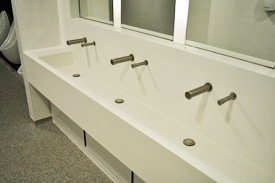Solid surface wash troughs
Contents |
[edit] Introduction
Solid surface wash troughs are a low-maintenance, cost-effective alternative to individual handwash basins. Comprising a long, narrow basin with a tap for each user, a hand wash trough can accommodate multiple users while requiring far less plumbing than an individual basin.
Instead of filling the wash trough with a mixture of hot and cold water, as with an individual basin, wash troughs are normally fitted with a mixer tap which supplies water ready mixed at a comfortable hand-washing temperature. Fitting a thermostatic water mixing valve, which ensures that the water delivered to the tap does not exceed a specified temperature, can help reduce the risk of scalding and ensure user comfort.
[edit] About solid surface
Solid surface was invented by DuPont in the late 1960s as a low-cost, low-maintenance alternative to natural materials such as marble and granite. The initial product from DuPont was called Corian, but since the expiration of the patent, a number of other manufacturers have begun producing solid surface products, such as Formica and Hi-Macs.
While the composition of each product varies, solid surface is typically made up of natural minerals (such as marble dust or bauxite) and pigments, suspended in an acrylic polymer resin.
The unique properties of solid surface mean it can be joined together almost seamlessly by thermoforming, whereby the material is heated and moulded into the desired shape before being cooled again to set.
While it is most often used to make kitchen countertops, the versatility of solid surface material means that it can be used in any number of applications. Solid surface is particularly useful for wash troughs because it is both seamless and impermeable; this prevents water from pooling and creating the conditions that allow bacteria and mould to flourish.
Solid surface wash troughs are available in a huge range of colours and designs. They can also be custom made to suit the dimensions and aesthetic of any washroom.
[edit] How are solid surface wash troughs made?
Sheets of Solid surface material are cut to size and then heated to make them malleable. The softened sheet is then quickly placed onto a mould and transferred to a thermoforming machine, which uses a vacuum to draw the solid surface material to the shape of the mould. This process is repeated for each individual component. Finally, the individual pieces are joined together and sanded down for a smooth, seamless finish.
[edit] Where are they used?
Solid surface wash troughs are rarely used in a domestic setting; they are much more commonly found in high-traffic venues such as public conveniences, workplaces and schools.
In fact, the Department for Education and Skills (now called the Department for Education) recommended wash troughs over individual basins in its Toilets in Schools guidance, stating that they are ‘easier to clean, aesthetically more pleasing, and reduce the potential for pupils to flood the toilets’.
[edit] Cleaning a solid surface wash trough
Solid surface material is easy to clean and does not require specialist detergents or cleaning products; simply wash the surface with warm soapy water or any ammonia-based household cleaner.
To avoid scratching the surface of the wash trough, you should use a soft microfibre cloth, and never abrasive cleaning pads or scourers. Using a circular motion when wiping the wash trough will ensure the best finish.
Periodically, ‘deep clean’ solid surface wash troughs. To do so, spray down the wash trough with a mixture of three parts household bleach and one part water, then leave overnight. In the morning, remove the residue with a damp cloth before rinsing thoroughly.
This article was originally written by Paul Thorn, MD of Washware Essentials, who provide a range solid surface wash troughs. They also supply urinals, toilets and accessories.
[edit] Related articles on Designing Buildings
Featured articles and news
Grenfell Tower fire – eight years on
A time to pause and reflect as Dubai tower block fire reported just before anniversary.
Airtightness Topic Guide BSRIA TG 27/2025
Explaining the basics of airtightness, what it is, why it's important, when it's required and how it's carried out.
Construction contract awards hit lowest point of 2025
Plummeting for second consecutive month, intensifying concerns for housing and infrastructure goals.
Understanding Mental Health in the Built Environment 2025
Examining the state of mental health in construction, shedding light on levels of stress, anxiety and depression.
The benefits of engaging with insulation manufacturers
When considering ground floor constructions.
Lighting Industry endorses Blueprint for Electrification
The Lighting Industry Association fully supports the ECA Blueprint as a timely, urgent call to action.
BSRIA Sentinel Clerk of Works Training Case Study
Strengthening expertise to enhance service delivery with integrated cutting-edge industry knowledge.
Impact report from the Supply Chain Sustainability School
Free sustainability skills, training and support delivered to thousands of UK companies to help cut carbon.
The Building Safety Forum at the Installershow 2025
With speakers confirmed for 24 June as part of Building Safety Week.
The UK’s largest air pollution campaign.
Future Homes Standard, now includes solar, but what else?
Will the new standard, due to in the Autumn, go far enough in terms of performance ?
BSRIA Briefing: Cleaner Air, Better tomorrow
A look back at issues relating to inside and outside air quality, discussed during the BSRIA briefing in 2023.
Restoring Abbotsford's hothouse
Bringing the writer Walter Scott's garden to life.
Reflections on the spending review with CIAT.
Retired firefighter cycles world to raise Grenfell funds
Leaving on 14 June 2025 Stephen will raise money for youth and schools through the Grenfell Foundation.
Key points for construction at a glance with industry reactions.
Functionality, visibility and sustainability
The simpler approach to specification.























